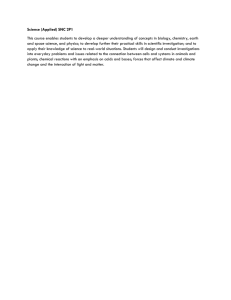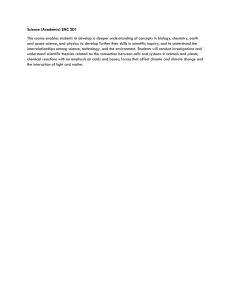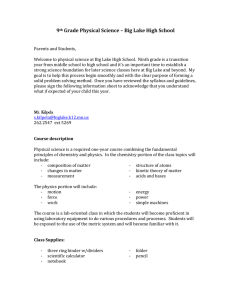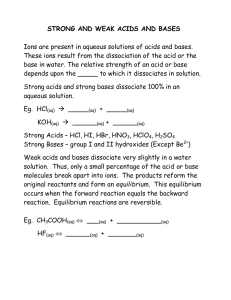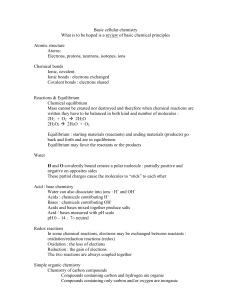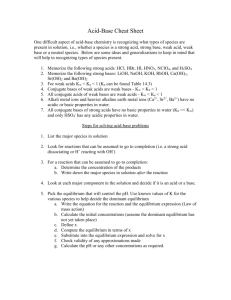COURSE SYLLABUS GPC - Dunwoody (1/6/07)
advertisement
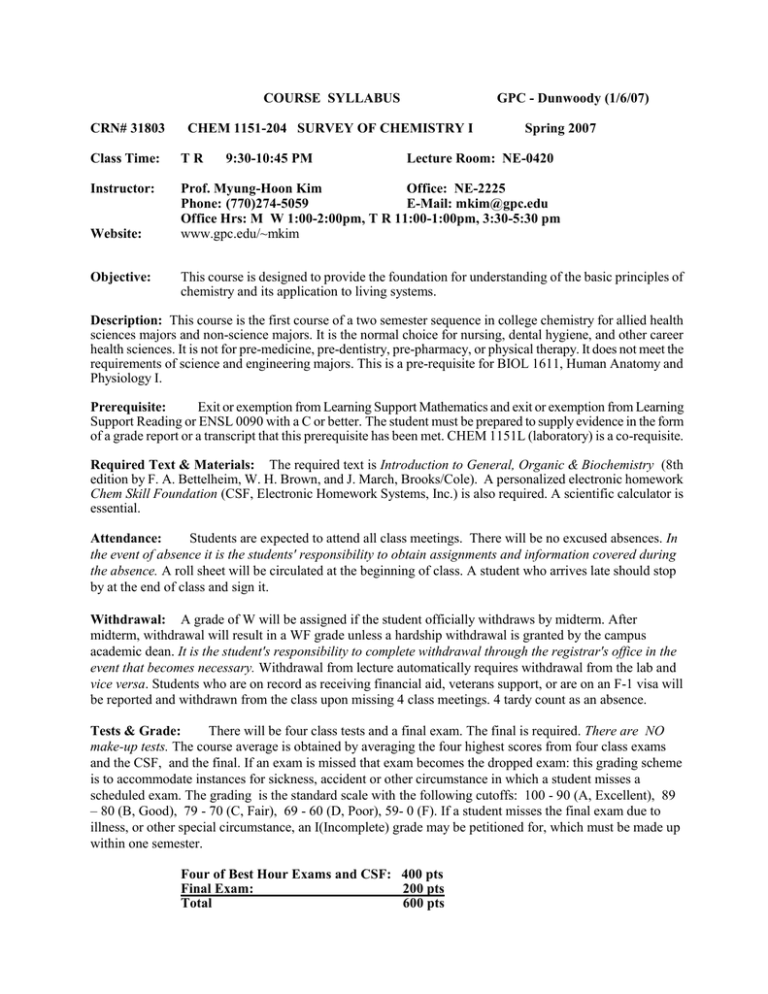
COURSE SYLLABUS CRN# 31803 GPC - Dunwoody (1/6/07) CHEM 1151-204 SURVEY OF CHEMISTRY I Class Time: TR Instructor: Prof. Myung-Hoon Kim Office: NE-2225 Phone: (770)274-5059 E-Mail: mkim@gpc.edu Office Hrs: M W 1:00-2:00pm, T R 11:00-1:00pm, 3:30-5:30 pm www.gpc.edu/~mkim Website: Objective: 9:30-10:45 PM Spring 2007 Lecture Room: NE-0420 This course is designed to provide the foundation for understanding of the basic principles of chemistry and its application to living systems. Description: This course is the first course of a two semester sequence in college chemistry for allied health sciences majors and non-science majors. It is the normal choice for nursing, dental hygiene, and other career health sciences. It is not for pre-medicine, pre-dentistry, pre-pharmacy, or physical therapy. It does not meet the requirements of science and engineering majors. This is a pre-requisite for BIOL 1611, Human Anatomy and Physiology I. Prerequisite: Exit or exemption from Learning Support Mathematics and exit or exemption from Learning Support Reading or ENSL 0090 with a C or better. The student must be prepared to supply evidence in the form of a grade report or a transcript that this prerequisite has been met. CHEM 1151L (laboratory) is a co-requisite. Required Text & Materials: The required text is Introduction to General, Organic & Biochemistry (8th edition by F. A. Bettelheim, W. H. Brown, and J. March, Brooks/Cole). A personalized electronic homework Chem Skill Foundation (CSF, Electronic Homework Systems, Inc.) is also required. A scientific calculator is essential. Attendance: Students are expected to attend all class meetings. There will be no excused absences. In the event of absence it is the students' responsibility to obtain assignments and information covered during the absence. A roll sheet will be circulated at the beginning of class. A student who arrives late should stop by at the end of class and sign it. Withdrawal: A grade of W will be assigned if the student officially withdraws by midterm. After midterm, withdrawal will result in a WF grade unless a hardship withdrawal is granted by the campus academic dean. It is the student's responsibility to complete withdrawal through the registrar's office in the event that becomes necessary. Withdrawal from lecture automatically requires withdrawal from the lab and vice versa. Students who are on record as receiving financial aid, veterans support, or are on an F-1 visa will be reported and withdrawn from the class upon missing 4 class meetings. 4 tardy count as an absence. Tests & Grade: There will be four class tests and a final exam. The final is required. There are NO make-up tests. The course average is obtained by averaging the four highest scores from four class exams and the CSF, and the final. If an exam is missed that exam becomes the dropped exam: this grading scheme is to accommodate instances for sickness, accident or other circumstance in which a student misses a scheduled exam. The grading is the standard scale with the following cutoffs: 100 - 90 (A, Excellent), 89 – 80 (B, Good), 79 - 70 (C, Fair), 69 - 60 (D, Poor), 59- 0 (F). If a student misses the final exam due to illness, or other special circumstance, an I(Incomplete) grade may be petitioned for, which must be made up within one semester. Four of Best Hour Exams and CSF: 400 pts Final Exam: 200 pts Total 600 pts (a) Each Hour Test has 25-33 Multiple Choices and 1-2 Big Write-Out Questions. (b) Bring #2 pencils and the Scantron Forms (882), not the NCS Forms. Classroom Conduct: Students are expected to act with respect for the professor and other classmates. Arriving late for class can be disruptive. In the event of a late arrival it is important to enter and take a seat quietly. Talking to others in the class during lecture/discussion prevents others from hearing the proceedings. Leaving class during session is very disruptive and should occur only in an emergency. Food and drink are not allowed in the classroom. Student’s Responsibility: Students must develop a fundamental understanding of chemical concepts as well as skill in solving problems, and the best way to do this is to rewrite class notes and work through examples and the exercise problems doing homework. The amount of time needed to be successful in this class may vary with background, interest, motivation, study skills, and ability. To be successful, expect a minimum of twice of the class time/wk outside of class to study and do homework. Concepts in chemistry build on one another, so it is important not to fall behind. Note that the student is responsible for information in the book that may not necessarily be covered in the lecture. The laboratory grade is separate and requires additional time. Expect 3 to 6 hours at home to prepare for a lab sessions, analyze data, find results, and prepare lab reports. Careful attention and good use of class time can reduce the time required outside of class. Remember that you earn a grade. CHEMISTRY 1151 SCHEDULE Wk 1 2 3 4 5 6 7 8 9 10 11 12 13 14 15 16 17 T Jan. R 9 16 23 Feb. 30 6 13 20 11 18 25 1 08 15 22 (27) 1 Mar ( 6 8) 13 15 20 22 27 29 Apr. 3 5 10 12 17 19 24 26 May 1 ( 3) 8 - Dates may be subject to change. - Test Topics & Reading Assignment of the Week Dates 1 Intro; Matter, Energy & measurement 1, 2 Matter, Energy & measurement; Atoms 2 Atoms 3 Nuclear Chemistry 3, 4 I Nuclear Chemistry, Chemical Bonds 4, Chemical Bonds; 5 Chemical Reactions 5 II Chemical Reactions - Spring Break - (Mid-point of Term: Mar. 13) 6 Gases, Liquids & Solids 6, 7 Gases, Liquids & Solids; Solutions & Colloids 7 III Solutions & Colloids 8 Reaction Rates & Chemical Equilibrium 8 Reaction Rates & Chemical Equilibrium 9 IV Acids and Bases, 9 Acids and Bases 1-9 Review 10:30 am Final ACS Standard Test(Comprehensive); CSF Due Chapter Other Information: (1) Chem Skill Foundations: One must score an average of 80 or above for each unit. (15 units; 7pts/unit). (2) You may visit the Course Website for sample exams from past and other information. (3) It is encouraged that you form a study group with classmates that meets regularly. (4) Extra Bonus points will be added to your total course score for catching any mistakes in lecture materials. Write down a mistake/correction with your name and date on a piece of paper and hand it in. (5) In the event that inclement weather strikes the Atlanta metro area, students are expected to tune into WSB radio (AM 750 kHz) or WSB television (Channel 2). CHEMISTRY 1151 COURSE CONTENTS Chapter 1 MATTER, ENERGY, and MEASUREMENTS 1. Introduction 2. Scientific Method 3. Exponential Notation and Significant Figure 4. Measurements and Units 5. Unit Conversions 6. The States of Matter 7. Density 8. Energy 9. Heat Chapter 2 ATOMS 1. Introduction 2. Classification of Matter 3. Dalton’s Atomic Theory 4. Inside an Atom 5. The Periodic Table 6. The Electronic Configurations of Atoms 7. The Periodic Table 8. Periodic Properties: Atomic Size & Ionization Energy of the Elements: - First Exam covers Chap. 1 & 2 Chapter 3 RADIOACTIVITY and NUCLEAR CHEMISTRY 1. Introduction 2. Radioactivity 3.What Happens When a Nucleus Emits Radioactivity? 4. Half-Life 5. Detection and Measurement of Radiation 6. Dosimetry and Human Health 7. Medical Uses of Radioactive Materials 8. Nuclear Fusion 9.Nuclear Fission and Aomic Energy Chapter 4 CHEMICAL BONDS 1. Introduction 2. Octet Rule 3. Naming Ions 4. Types of Chemical Bonds 5. Formation of Ionic Bond 6. Naming Ionic Compounds 7. Formation of Covalent Bond: Lewis Structure 8. Naming Binary Molecular Compounds 9. Resonance 10.Bond Angles and Shapes of Molecules 11. Polarity of Molecules - Second Exam covers Chap. 3 & 4 Chapter 5 CHEMICAL REACTIONS 1. Introduction 2. Molecular Weight & Formula Weight 3. The Mole 4. Balancing Chemical Equations 5. Mass Relationships in Chemical Reactions 6.Reaction between Ions in Aqueous Solution 7. Oxidation-Reduction 8. Heat of Reaction Chapter 6 STATES of MATER: Gases, Liquids, and Solids 1. Three States of Matter 2. Gas Pressure 3. Gas Laws 4. Avogadro’s Law and Ideal Gas Law 5. Dalton's Law of Partial Pressure 6. The Kinetic Molecular Theory 7. Types of Attractive Forces between Molecules 8. Behavior of Liquids 9. Types of Solids 10. Phase Changes and Energy Involved. - Third Exam covers Chap. 5 & 6 Chapter 7 SOLUTIONS and COLLOIDS 1. Introduction 2. Types of Solutions 3. Characteristics of Solutions 4. Factors Affecting Solubility 5. Common Units for Concentration 6.Water as a Solvent 7. Colloids 8. Colligative Properties Chapter 8 REACTION RATES AND CHEMICAL EQUILIBRA 1. Introduction 2. Molecular Collisions 3. Activation Energy and Energy Diagrams 4. Factors Affecting Rates of Reaction 5. Reversible Reactions and Equilibrium 6. Equilibrium Constants 7. Equilibrium and Reaction Rates 8. Le Chatlier’s Principle - Fourth Exam covers Chap. 7 & 8 Chapter 9 ACIDS and BASES 1. Introduction 2. Strength of Acids and Bases 3. The Bronsted-Lowry Theory of Acids and Bases 4. The Position of Equilibrium in Acid-Base Reactions 5. Acid Ionization Constants 6. Some Properties of Acids and Bases 7. The Self-Ionization of Water 8. pH and pOH 9. The pH of aqueous Salt Solutions 10. Titration 11.Buffers 12. The Henderson-Hasselbalch Equation - Final Exam is comprehensive covering Chap. 1 – 9 Expected Educational Results: Upon successful completion of this course, students should be able to: 1. Relate law, hypothesis, theory, and the scientific method. 2. Convert decimal values to exponential notation: Use scientific notation in calculations 3. Use significant figures in calculation. 4. Demonstrate proficiency in the metric system and be able to convert metric and British units. 5. Use density relationships. 6. Convert temperatures among the different scales. 7. Name common elements from symbols, and write symbols for names. 8. Write complete symbols for atoms. 9. Distinguish between element, compound, and mixture. 10. Demonstrate understanding of atomic structure - protons, neutrons, and electrons. 11. Write out electron configurations for first 56 elements. 12. Relate intermolecular forces to physical properties such as boiling point. 13. Name compound from formula and write formula from name. 14. Write Lewis electron-dot structures for atoms and ions. 15. Identify ionic and covalent bonds. 16. Use electronegativity to determine bond polarity. 17. Predict molecular geometries, and relate polarity and molecular geometry. 18. Balance chemical equations. 19. Classify chemical reactions. 20. Calculate formula weight (from formula) and molar mass of an element or compound. 21. Convert moles of substance to grams and vice versa. 22. Use empirical gas laws and ideal gas laws. 23. Identify colligative properties. 24. Distinguish between colloids and solutions. 25. Define radiation and half-life. 26. Relate quantities in a chemical equation (stoichiometry), and find a limiting reactant. 27. Calculate molarity from mass and volume, and carry out dilution calculations. 28. Carry out solution stoichiometry calculations. 29. Classify strong and weak acids and bases. 30. Write complete and net ionic equations; Write neutralization equations. 31. Carry out calculations involving heat of reaction. 32. Distinguish between exothermic and endothermic. 33. Define electrolyte. 34. Apply periodic trends to atomic radius, ionization energy, and electronegativity. 35. Outline unique properties of water. 36. Determine osmolarity. 37. Define Ka and pKa and relate to acid strength. 38. Define Arrhenius and Bronsted-Lowry acids and bases. 39. Calculate [H3O+] and [OH-] given appropriate information. 40. Calculate pH or pOH of a solution. 41. Identify buffer solutions and describe how buffers work. 42. Identify factors that effect rates of reaction. 43. Define activation energy and catalyst. 44. Write equilibrium expression and determine K. 45.-Use LeChatelier’s Principle. 46. Write a nuclear reaction and deduce a product or reactant.
